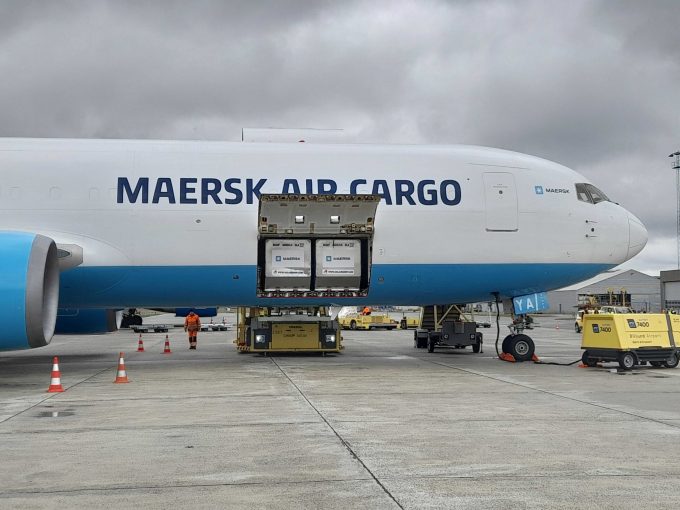Ecommerce drives growth at Liege, as Lufthansa Cargo doubles down on China
European fears of the sharp rise in Chinese ecommerce imports has not stemmed the flood. Liege ...
TFII: SOLID AS USUALMAERSK: WEAKENINGF: FALLING OFF A CLIFFAAPL: 'BOTTLENECK IN MAINLAND CHINA'AAPL: CHINA TRENDSDHL: GROWTH CAPEXR: ANOTHER SOLID DELIVERYMFT: HERE COMES THE FALLDSV: LOOK AT SCHENKER PERFORMANCEUPS: A WAVE OF DOWNGRADES DSV: BARGAIN BINKNX: EARNINGS OUTODFL: RISING AND FALLING AND THEN RISING
TFII: SOLID AS USUALMAERSK: WEAKENINGF: FALLING OFF A CLIFFAAPL: 'BOTTLENECK IN MAINLAND CHINA'AAPL: CHINA TRENDSDHL: GROWTH CAPEXR: ANOTHER SOLID DELIVERYMFT: HERE COMES THE FALLDSV: LOOK AT SCHENKER PERFORMANCEUPS: A WAVE OF DOWNGRADES DSV: BARGAIN BINKNX: EARNINGS OUTODFL: RISING AND FALLING AND THEN RISING

Maersk Air Cargo’s inaugural flight to China this morning from its new-old hub at Billund Airport attracted the great and the good of Denmark – including not one, but two government ministers (business and transport), revealing how important the company is to its home country.
Maersk is offering its customers three flights a week to Hangzhou, the first scheduled air cargo operation between Denmark and China, according to EVP Europe Aymeric Chandavoine.
“We expect the corridor to significantly increase,” he added.
Some 50% of Maersk’s customers use air freight – and now they can use Maersk for that too, and the group is also working as a forwarder.
“We have capacity on our own fleet, as well as on other commercial airlines,” explained Michel Pozas Lucic, global head of air for APMM. “We work primarily with BCOs, but we will work with any customers,” he added – although he was hesitant when asked directly about freight forwarders.
“We will have a mix of business, from medium and long-term contracts as well as spot. It’s best to have a mix of the two. It’ll never be primarily one specific thing.”
With one eye on the spot market, is the current weakness concerning? He said: “I’ve never seen the market collapse like it did in November and December. In January, the Chinese export market was down 45%! But I think we’ve bottomed-out.
“I think we’ll see a rebound in Q2, with normal numbers again, and a normal Q4. I’ve never seen an end-of-year like 2022 where there wasn’t a surge, but I expect it to be more normal this year.”
He said inventories were still something of a mixed bag, with some customers starting to order again, others still waiting for stocks to dwindle.
The carrier is expected to announce another Asian route from Europe soon. With three aircraft to be based at Billund for now, the operator plans to go up to 12 flights a week. New verticals, such as pharma and DG, will be introduced as and when the carrier is capable on each lane.
Mr Pozas Lucic said Maersk already saw itself as a medium-sized carrier – but that it was also “a start-up on steroids”.
Mr Chandavoine added that the Asia-Europe airfreight launch was another part of Maersk’s jigsaw to connect supply chains.
“Logistics can be overwhelming; it can look like a large jigsaw puzzle,” he said. “It can be very complicated. Air, ocean and land, and sometimes combined. A single issue can disrupt the entire flow. One shipment may have 20 parties involved around the world, using different systems in different time zones.
“By integrating logistics, we are putting the pieces of the puzzle back together – one partner, one system. You know where your cargo is at every step. And this air route to China will solve individual customer needs as well as connecting other pieces.”
Billund Airport, meanwhile, was thrilled to be the backdrop for Maersk’s big day out, “an old friend”, said Mr Chandavoine.
Spacious, with Maersk’s warehouse right next to the apron, and in a corner of the airport untroubled by the likes of Ryanair, it looks set to be an efficient cargo hub. Three aircraft were on offer for the delight of the crowd: a new Amerijet-operated 767, on its way back to the US tonight; an old-school Star Air aircraft; and the converted 767, set for China.
ACL Airshop containers were prominently on display at the cargo centre, which is nestled, handily, at the end of the Legoland car park.
Maersk will truck-in freight from the Nordics and northern Germany for its three aircraft. And the first aircraft, looking full, left right on time.
Comment on this article